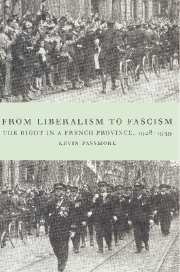Book contents
- Frontmatter
- Contents
- List of illustrations
- Preface
- List of abbreviations
- 1 Introduction
- 2 From France to the Rhône
- 3 Urban society in the Rhône
- 4 Rural society in the Rhône
- 5 The crisis of the right I: 1928–1932
- 6 The impact of the economic crisis
- 7 The crisis of the right II: 1932–June 1936
- 8 The Croix de Feu
- 9 The right and the Popular Front
- 10 Conclusion
- Appendix 1 Equations for multiple regressions
- Appendix 2 The conservative deputies of the Rhône, 1928–1940
- Select bibliography
- Index
2 - From France to the Rhône
Published online by Cambridge University Press: 23 December 2009
- Frontmatter
- Contents
- List of illustrations
- Preface
- List of abbreviations
- 1 Introduction
- 2 From France to the Rhône
- 3 Urban society in the Rhône
- 4 Rural society in the Rhône
- 5 The crisis of the right I: 1928–1932
- 6 The impact of the economic crisis
- 7 The crisis of the right II: 1932–June 1936
- 8 The Croix de Feu
- 9 The right and the Popular Front
- 10 Conclusion
- Appendix 1 Equations for multiple regressions
- Appendix 2 The conservative deputies of the Rhône, 1928–1940
- Select bibliography
- Index
Summary
Until 1870 politics in the Rhone were dominated by liberal constitutional monarchists who found their ideal in the July Monarchy and then rallied to the Empire. But in the first decade of the Third Republic the right was marginalised by the triumph of the Republicans, who won every parliamentary seat in the department from 1876 until 1889. In the 1890s a Republican liberal-conservatism known to contemporaries as ‘Progressisme’ and led by Edouard Aynard began to regain ground. It soon won a dominant position on the right, though it never seriously threatened the left. In 1904 the Progressiste Fédération des comités républicans du sixième arrondissement appeared. It was extended to cover the whole of the conurbation and then the department, and in 1905 adhered to the Fédération républicaine, which had been founded in Paris in November 1903 by Eugène Motte to regroup the anti-Dreyfusard majority of the Opportunists. From the turn of the century until the rise of the Croix de Feu the Fédération was to be the predominant conservative party in the Rhône. It regularly elected three or four of the department's twelve (thirteen from 1928) deputies and gradually improved its share of the vote over the next decades.
To make sense of the crisis of the Lyonnais right in the 1930s it is necessary to understand the conditions in which the Fédération emerged as the dominant conservative party. This raises some broad questions about the right in the 1890s, a period widely regarded as the cradle of modern conservatism.
- Type
- Chapter
- Information
- From Liberalism to FascismThe Right in a French Province, 1928–1939, pp. 20 - 55Publisher: Cambridge University PressPrint publication year: 1997

